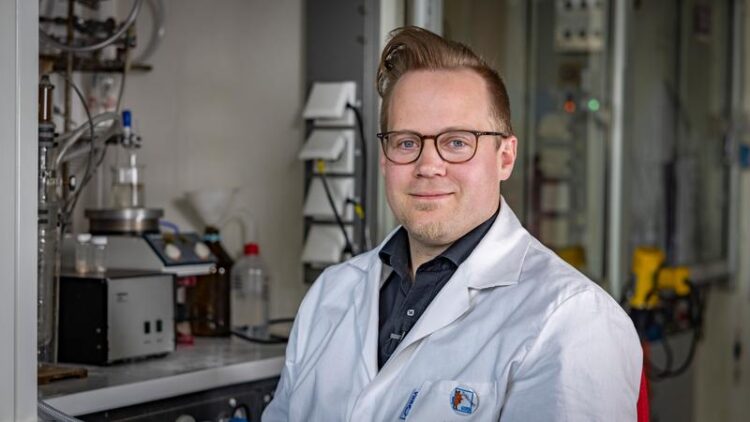Fundamental Problem Solved

Prof. Dr. Johannes Teichert from Chemnitz University of Technology demonstrated neutral homoaromatic compounds for the first time.
Photo: Jacob Müller / Chemnitz University Technology
Chemists from Chemnitz prepared long searched Chemical Compound for the First Time.
High-profile publication in the journal Nature Chemistry: Prof. Dr. Johannes Teichert and his team from Chemnitz University of Technology successfully show the existence of the neutral homoaromatic compound.
In a recent issue of the renowned and highly cited international journal Nature Chemistry, Prof. Dr. Johannes Teichert, head of the Professorship of Organic Chemistry at Chemnitz University of Technology, his research assistant Trung Tran Ngoc, and other contributors report on a so-called “neutral homoaromatic compound”.
The findings are a milestone for organic chemistry, as chemists had only proposed the existence of this class of molecules for more than 70 years. Practical evidence had been lacking until now.
“With this groundbreaking discovery, we were able to solve a fundamental problem in chemistry and demonstrate for the first time, that the long-assumed but never prepared neutral homoaromatic compounds actually exist in organic chemistry”, says Teichert. “This is nothing less than a breakthrough for organic chemistry – also because we have characterized these compounds for the first time with their individual properties”, Teichert continues.
The homoaromatic molecules produced by Teichert and his team can, for example, be used as “replacement building blocks” for classical aromatic molecules. This opens up entirely new combination possibilities and approaches for developing new materials or active substances in medicine.
First stable synthesis and targeted modification
While classical aromatic molecules are characterized by their cyclic structure and a circular movement of electrons, this ring is interrupted in homoaromatic compounds.
However, if the reactive ends of the molecule are held in an exact geometry, the circular movement of the electrons is maintained even without a “real” bond. This connection of molecules beyond a classical chemical bond is a special property of the homoaromatic compounds produced by Teichert and his team. “For the first time, we can now investigate and systematically modify the molecular interactions within the homoaromatic compounds,” adds Teichert’s assistant Trung Tran Ngoc. “The stability of the compound allows us to intensively explore and better understand the concept of homoaromaticity,” Teichert adds.
New photochemical switches enable new research paths, e.g., in biomedicine
With the discovery of this new form of chemical compounds, a new type of photochemical switch is also introduced. So-called “photoswitches” play an important role in medicine and biomedicine, among other fields. These switches can, for example, be used to specifically stimulate active substances in the human body from the outside using light, activating and investigating their effects on-site.
Publication: Tran Ngoc, T., Grabicki, N., Irran, E. et al. Photoswitching neutral homoaromatic hydrocarbons. Nat. Chem. 15, 377–385 (2023).
DOI: https://doi.org/10.1038/s41557-022-01121-w
For more information, please contact Prof. Dr. Johannes Teichert, tel. +49 371 531-33715, e-mail johannes.teichert@chemie.tu-chemnitz.de
(Article: Matthias Fejes / Translation: Brent Benofsky)
Media Contact
All latest news from the category: Life Sciences and Chemistry
Articles and reports from the Life Sciences and chemistry area deal with applied and basic research into modern biology, chemistry and human medicine.
Valuable information can be found on a range of life sciences fields including bacteriology, biochemistry, bionics, bioinformatics, biophysics, biotechnology, genetics, geobotany, human biology, marine biology, microbiology, molecular biology, cellular biology, zoology, bioinorganic chemistry, microchemistry and environmental chemistry.
Newest articles

First-of-its-kind study uses remote sensing to monitor plastic debris in rivers and lakes
Remote sensing creates a cost-effective solution to monitoring plastic pollution. A first-of-its-kind study from researchers at the University of Minnesota Twin Cities shows how remote sensing can help monitor and…

Laser-based artificial neuron mimics nerve cell functions at lightning speed
With a processing speed a billion times faster than nature, chip-based laser neuron could help advance AI tasks such as pattern recognition and sequence prediction. Researchers have developed a laser-based…

Optimising the processing of plastic waste
Just one look in the yellow bin reveals a colourful jumble of different types of plastic. However, the purer and more uniform plastic waste is, the easier it is to…



